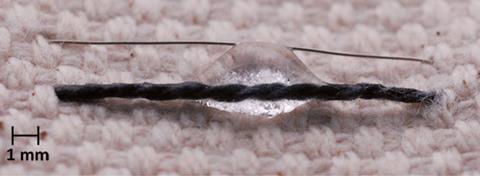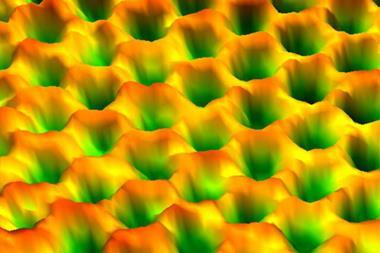Scientists in Italy have integrated a device to monitor the salt concentration of sweat into a cotton fibre. The fibre can then be embedded into cloth and could be used to monitor hydration levels in athletes by measuring how much they are sweating.

Functionalised fibres have been proposed as electronic sensors before but they only work with gel or solid electrolytes. As a result, they require complex fabrication techniques, are cumbersome when integrated into fabrics and are unable to detect liquids.
To overcome these challenges, Nicola Coppedè and colleagues from the Institute of Materials for Electronics and Magnetism in Parma made a device that can use a liquid as an electrolyte – in this case sweat – so that it can be used as a liquid sensor.
The team functionalised a cotton fibre with a conductive polymer (PEDOT:PSS; poly(3,4-ethylenedioxythiophene:poly(styrene sulfonate)) and a silver wire. It is fully compatible with standard clothing, says Coppedè. Even when impregnated with the conductive polymer, the thread keeps its mechanical characteristics and thin silver wires are already commonly used in textile manufacturing.
The functionalised fibre can measure the current passing through it when it makes contact with the silver wire thanks to the sweat from the athlete. A voltage applied to the wire moves the ionic species in the liquid to the cotton thread, changing its conductivity. The change depends on the concentration of the saline ions diluted in the liquid.
‘We applied the sensor to detect the concentration of salt in human sweat, to monitor stress conditions when doing sport,’ explains Coppedè. The team used the device on athletes after 10 minutes of jogging and then again after 40 minutes to compare results. They found that the salt concentration decreased significantly for all athletes.‘By a simple electric measurement we could detect, in real time, the hydration condition of an athlete using a low cost device, which could easily be integrated into cloth,’ he adds.
‘It is quite interesting work and is an important step towards the development of electronic textiles,’ says Zijian Zheng from the Institute of Textiles and Clothing at the Hong Kong Polytechnic University. He adds that as the fabrication of PEDOT:PSS coated cotton yarn is simple, it could be scaled up and used in a more complicated and realistic garment. However, he points out that PEDOT:PSS-coated cotton may not be stable enough in the long term. ‘It is known that PEDOT:PSS is not that stable and it absorbs moisture. Also, PEDOT:PSS is acidic, which can be very harmful to cellulose [cotton is made up of about 90% cellulose]. Cellulose degrades in acidic conditions,’ he adds.
As well as monitoring athletes, Coppedè also wants to use the device to monitor the clinical condition of unconscious patients. ‘We could evaluate dehydration or other clinical problems, which represent a possible risk if not detected in time, through changes in sweat characteristics and reveal them by the simple device in the textile,’ he says.






No comments yet